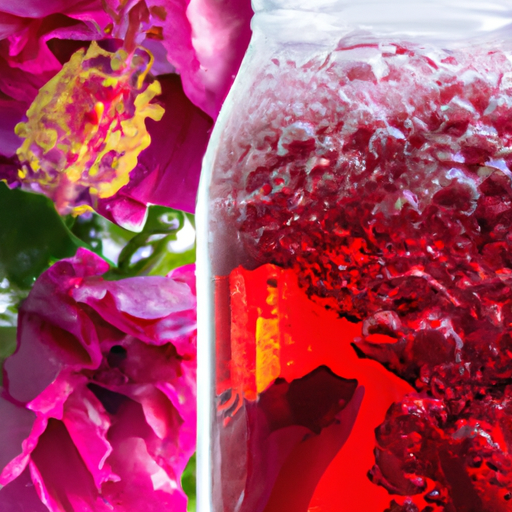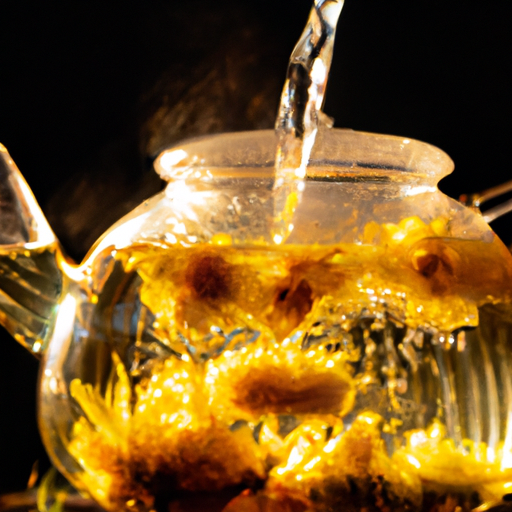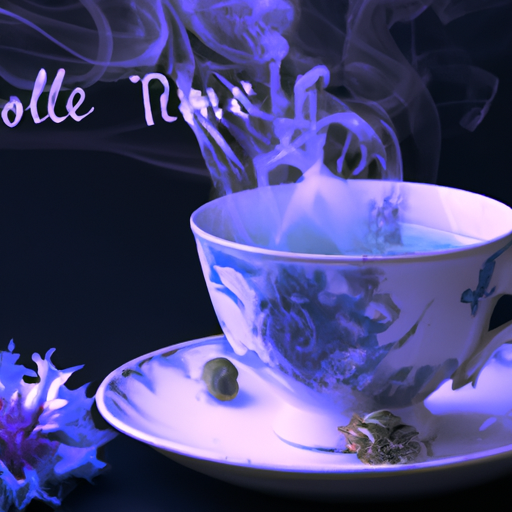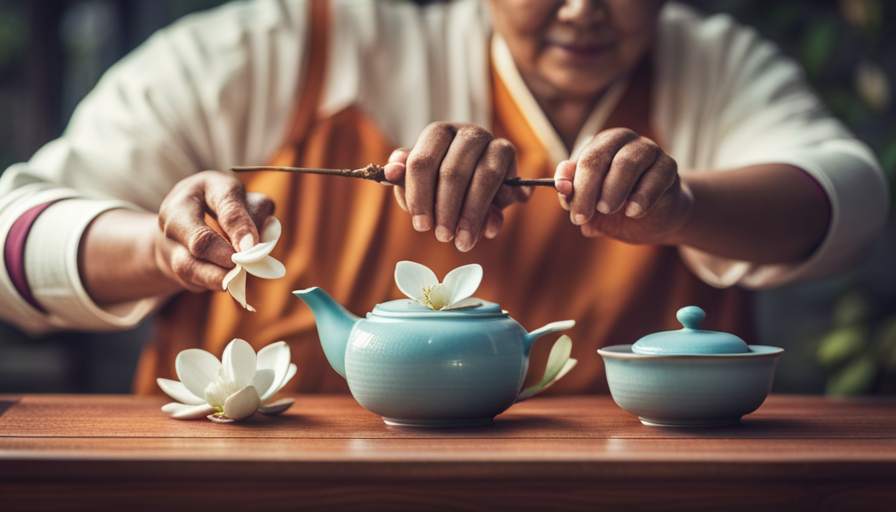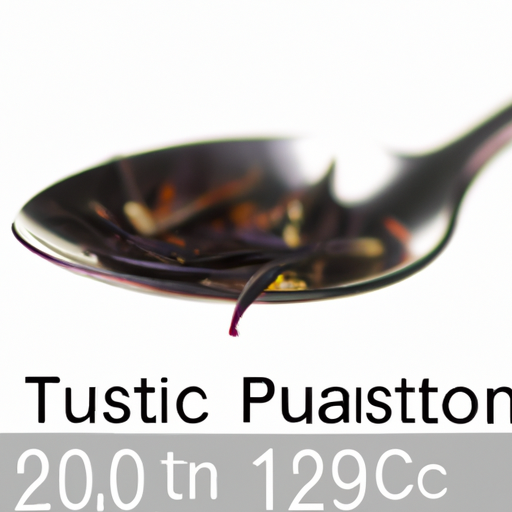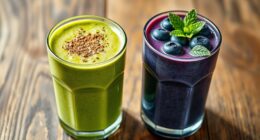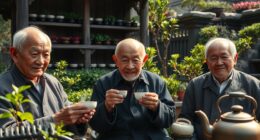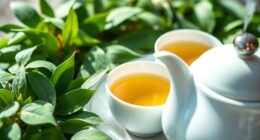They say that the key to a healthy body and mind is found in nature’s bounty. And what better way to tap into that power than by brewing your own kombucha at home? In this article, I will guide you through the fascinating process of making hibiscus flower tea kombucha, a delightful and refreshing variation of this ancient fermented drink.
Kombucha has been cherished for centuries due to its numerous health benefits, including improved digestion, increased energy, and a strengthened immune system. By combining the vibrant flavors of hibiscus flower tea with the probiotic goodness of kombucha, you can create a beverage that not only tastes amazing but also supports your overall well-being.
Throughout this article, I will provide you with step-by-step instructions on how to create your own homemade hibiscus flower tea kombucha. From gathering your ingredients and preparing the tea, to fermenting and flavoring the kombucha, I will walk you through each stage of the process.
So, let’s dive in and unlock the secrets of this invigorating elixir together!
Key Takeaways
- Hibiscus flower tea kombucha is a fermented drink with health benefits like improved digestion and increased energy.
- Making hibiscus flower tea kombucha involves combining hibiscus flower tea with a SCOBY (Symbiotic Culture of Bacteria and Yeast).
- The fermentation process involves the SCOBY consuming sugars and releasing beneficial acids, enzymes, and probiotics, resulting in a tangy and fizzy kombucha.
- Adjusting fermentation time can impact the flavor and acidity of the kombucha, with longer fermentation resulting in a more tart and tangy flavor and enhanced probiotic content for gut health.
Gather Your Ingredients and Supplies
Now that you’re ready to embark on your hibiscus flower tea kombucha journey, it’s time to gather all the ingredients and supplies you’ll need to create this delicious and refreshing beverage.
First, you’ll need to get your hands on some high-quality hibiscus flower tea. You can find this at your local health food store or order it online. Make sure to choose organic tea to ensure the purest flavor and maximum health benefits.
Next, you’ll need a SCOBY (Symbiotic Culture of Bacteria and Yeast) to kickstart the fermentation process. You can either purchase a SCOBY or make your own using a kombucha starter kit.
Additionally, gather some filtered water, organic cane sugar, and glass jars for brewing and storing your kombucha.
Experiment with different brewing methods to find your perfect balance of flavors. Some people prefer a shorter fermentation time for a sweeter and less acidic taste, while others enjoy a longer fermentation for a more tangy and probiotic-rich brew. It’s all about finding what works best for your taste buds and health goals.
Before we dive into the brewing process, let’s explore the health benefits of hibiscus flower tea. This vibrant red tea is packed with antioxidants and has been known to promote heart health, lower blood pressure, and support digestion. Its tart and tangy flavor adds a refreshing twist to your kombucha, making it a wonderful addition to your wellness routine.
Now that we’ve gathered our ingredients and learned about the health benefits of hibiscus flower tea, let’s move on to the next step: preparing the hibiscus flower tea.
Prepare the Hibiscus Flower Tea
First off, let’s get our hands on some vibrant hibiscus petals. Hibiscus flower tea is not only visually stunning, but it also offers numerous health benefits. To brew hibiscus flower tea, start by bringing water to a boil. For every cup of water, add 2 tablespoons of dried hibiscus petals to a teapot or heatproof container. Pour the boiling water over the petals and let it steep for about 5-10 minutes. The longer you steep, the stronger the flavor will be.
Hibiscus flower tea is known for its rich antioxidant content, which helps to protect the body from free radical damage. It is also believed to have anti-inflammatory properties and may support heart health by reducing blood pressure and cholesterol levels. Additionally, hibiscus flower tea can aid digestion and promote weight loss.
To fully enjoy the brewing process, refer to the table below:
| Step | Instructions |
|---|---|
| 1 | Bring water to a boil |
| 2 | Add dried hibiscus petals to a teapot |
| 3 | Pour boiling water over the petals |
| 4 | Let it steep for 5-10 minutes |
| 5 | Strain and enjoy! |
Now that we have prepared the hibiscus flower tea, it’s time to cool it down and add the scoby to begin the fermentation process.
Cool the Tea and Add the SCOBY
Once you’ve steeped the vibrant hibiscus petals in boiling water, it’s time to cool the fragrant infusion and introduce the SCOBY to kickstart the exciting fermentation process.
Cooling the tea is an essential step in the kombucha-making process, as it allows the liquid to reach a temperature that won’t harm the SCOBY. To cool the tea, simply remove it from the heat source and let it sit at room temperature for about an hour. You can also place the pot in an ice bath to expedite the cooling process.
Remember, it’s crucial to ensure that the tea is completely cool before adding the SCOBY, as heat can damage the delicate culture. Once the tea has cooled, carefully transfer it to a clean glass jar, leaving some space at the top for the SCOBY and starter liquid. Gently place the SCOBY on top of the tea, making sure it’s fully submerged. This will provide the SCOBY with the nutrients it needs to thrive and transform the sweet tea into tangy, probiotic-rich kombucha.
Now that the tea and SCOBY are combined, it’s time to cover the jar and allow the fermentation magic to happen. This step will be discussed further in the next section about covering and fermenting the kombucha.
Cover and Ferment the Kombucha
To achieve the transformative alchemy of fermentation, you must gently drape a protective cloth over the vessel and allow the mysterious interplay of time and microorganisms to work their magic. This crucial step in making hibiscus flower tea kombucha is what sets it apart from other beverages. Once you have covered the vessel, the fermentation process begins, and the SCOBY starts to work its wonders.
During fermentation, the SCOBY consumes the sugars in the tea and releases beneficial acids, enzymes, and probiotics. This is where the magic happens, as the kombucha transforms into a tangy and fizzy drink with a unique flavor profile. It’s fascinating to witness the transformation unfold over time, as the kombucha gradually becomes more complex and flavorful.
As you wait for the fermentation process to complete, you can experiment with different flavors. Adding fruits, herbs, or spices to the kombucha during the second fermentation can create a whole new taste experience. The possibilities are endless, allowing you to customize your kombucha to suit your preferences.
By monitoring the fermentation process closely, you can ensure that your kombucha reaches the desired level of acidity and carbonation. This will be discussed in more detail in the next section, where we will delve into the importance of monitoring the fermentation process.
Monitor the Fermentation Process
When monitoring the fermentation process of my hibiscus flower tea kombucha, I make sure to check for carbonation and taste.
Carbonation is an important indicator of fermentation progress, as it gives the kombucha its signature fizziness.
By tasting the kombucha regularly, I can also assess its flavor profile and determine if any adjustments to the fermentation time are needed to achieve the desired taste.
Check for Carbonation and Taste
Now, don’t forget to give your hibiscus flower tea kombucha a little taste test to check for that delightful carbonation! Here are four key things to consider when checking for carbonation and taste:
-
Observe the bubbles: Look for a good amount of fizziness when you open the bottle. Bubbles indicate proper carbonation levels.
-
Assess the flavor: Take a small sip and pay attention to the taste. Is it too sweet, too sour, or just right? Adjust the flavor profile by adding more sweetener or tartness if needed.
-
Evaluate the acidity: Hibiscus kombucha should have a balanced acidity. If it tastes too acidic, reduce the fermentation time in the next batch. If it’s not acidic enough, let it ferment for a bit longer.
-
Consider personal preference: Ultimately, the taste of your kombucha is subjective. Adjust the flavors and carbonation levels according to your liking.
Now that you’ve checked for carbonation and taste, let’s move on to adjusting the fermentation time if needed.
Adjust Fermentation Time if Needed
If the acidity of your hibiscus kombucha is unbalanced, simply adjust the fermentation time to achieve the desired flavor. The adjustment of fermentation time can have a significant impact on the taste and acidity of your kombucha. By extending the fermentation time, you allow the bacteria and yeast to further metabolize the sugars present in the tea, resulting in a more tart and tangy flavor. This longer fermentation also enhances the probiotic content of your kombucha, providing potential benefits for gut health and digestion. On the other hand, if your kombucha is already too acidic, reducing the fermentation time can help achieve a milder taste. Experimenting with different fermentation times will help you find the perfect balance for your hibiscus kombucha. Once you have achieved the desired flavor, you can proceed to bottle and store the kombucha.
Bottle and Store the Kombucha
When it comes to bottling and storing kombucha, it’s crucial to choose the right bottles and seal them properly to ensure the quality and taste of the final product. Glass bottles with airtight seals are ideal for maintaining carbonation and preventing any contamination.
Additionally, storing the kombucha at the right temperature is important. Typically, it should be kept around 38-42°F (3-6°C). This temperature helps slow down the fermentation process and maintain the flavor and fizziness of the kombucha.
By following these steps, you can ensure that your kombucha is stored correctly and ready to be enjoyed whenever you’re ready to indulge.
Choose the Right Bottles and Seal Them Properly
To ensure a successful fermentation, seal your chosen bottles tightly and use this opportunity to infuse the hibiscus flower tea kombucha with your own personal touch.
Choosing the right bottles and ensuring proper sealing is crucial for the kombucha fermentation process. When it comes to selecting bottles, opt for ones that are made of glass and have airtight seals. This helps maintain the carbonation and prevents any unwanted bacteria from entering the brew. Swing-top bottles or bottles with rubber gaskets are great options.
Make sure to clean and sanitize the bottles thoroughly before use. Additionally, ensure that the seals are tight to prevent any leaks or loss of carbonation. By choosing the right bottles and sealing them properly, you can create a delicious and effervescent hibiscus flower tea kombucha.
Now, let’s move on to storing the kombucha at the right temperature to further enhance its flavor and fermentation.
Store the Kombucha at the Right Temperature
Ensure that you store your homemade hibiscus kombucha at the right temperature to maximize its flavor and fermentation process. Maintaining the correct temperature is crucial for the growth of beneficial bacteria and yeasts, which are responsible for the fermentation process.
The ideal temperature range for kombucha fermentation is between 68-78°F (20-26°C). Temperatures that are too high can lead to a faster fermentation process, resulting in a less balanced and potentially sour taste. On the other hand, cooler temperatures can slow down fermentation, leading to a milder flavor.
It’s best to find a consistent spot in your home where the temperature remains within this range. You can use a thermometer to monitor the temperature regularly. By ensuring the right temperature, you can create a vibrant and delicious hibiscus kombucha.
Now, let’s move on to the second fermentation (optional) to enhance the flavor and carbonation.
Second Fermentation (Optional)
For an extra burst of flavor, you can add additional fruit or herbs during the second fermentation of your hibiscus flower tea kombucha. This step is completely optional, but it can take your homemade kombucha to the next level.
Here are three ideas to inspire you:
-
Fruity Infusion: Add slices of fresh fruits like strawberries, peaches, or oranges to your kombucha during the second fermentation. This will not only infuse the kombucha with a delicious fruity flavor but also provide additional natural sweetness.
-
Herbal Twist: Experiment with different herbs like mint, basil, or lavender. These herbs can add a refreshing and aromatic touch to your kombucha, elevating the overall taste experience.
-
Spicy Surprise: If you enjoy a little kick in your beverages, try adding spices like ginger, cinnamon, or cloves. These spices can add depth and warmth to your kombucha, creating a unique flavor profile.
Adding these extra ingredients during the second fermentation allows the kombucha to absorb their flavors, resulting in a more complex and satisfying beverage. Once the second fermentation is complete, it’s time to strain and refrigerate the kombucha to halt the fermentation process and enjoy its delicious taste.
Strain and Refrigerate the Kombucha
Once your homemade kombucha’s finished its second fermentation, it’s time to strain out any remaining fruit, herbs, or spices and pop it in the fridge for a refreshing and tangy treat. Refrigeration’s an important step in the process as it helps to slow down the fermentation and maintain the quality of your kombucha. By refrigerating the kombucha, you not only preserve its flavor and carbonation but also extend its shelf life.
The cold temperature inhibits the growth of bacteria and yeast, ensuring that your kombucha remains safe to consume for a longer period of time. To strain the kombucha, use a fine-mesh strainer or cheesecloth to remove any solid particles or sediment. This’ll result in a smoother and clearer tea. Once strained, transfer the kombucha to a glass bottle or jar with an airtight lid and place it in the refrigerator.
It’s recommended to refrigerate the kombucha for at least 24 hours before consumption to allow the flavors to meld and the carbonation to develop. If you prefer alternative storage methods, you can also consider keeping the kombucha at room temperature for a shorter period of time. However, keep in mind that this’ll continue the fermentation process, resulting in a more acidic and less sweet flavor profile. It’s best to experiment and find the storage method that suits your taste preferences.
Now that your hibiscus flower tea kombucha’s chilled and ready, it’s time to sit back, relax, and enjoy the refreshing and tangy flavors of your homemade brew.
Enjoy Your Homemade Hibiscus Flower Tea Kombucha
Indulge in the vibrant and invigorating flavors of your homemade hibiscus flower tea kombucha, as you savor each sip and let the tangy notes dance on your taste buds. This delightful drink not only pleases your palate but also offers numerous health benefits.
Here are three reasons why you’ll love this hibiscus flower tea kombucha:
-
Boosted Immunity: The fermentation process of kombucha enhances the bioavailability of nutrients in hibiscus flowers, resulting in a potent immune-boosting beverage. It’s packed with antioxidants and vitamins, making it a great way to strengthen your immune system and protect yourself from common illnesses.
-
Heart Health Support: Hibiscus flowers are known for their ability to support cardiovascular health. Studies have shown that hibiscus flower tea kombucha can help lower blood pressure and cholesterol levels, reducing the risk of heart diseases.
-
Digestive Aid: Kombucha, combined with the natural probiotics present in hibiscus flowers, promotes a healthy gut microbiome. Regular consumption of this tangy beverage can improve digestion, alleviate bloating, and enhance nutrient absorption.
Now that you’ve discovered the many benefits of hibiscus flower tea kombucha, you can experiment with different flavors and variations. Transitioning into the next section, let’s explore how to infuse your kombucha with exciting ingredients to create unique and tantalizing flavors.
Experiment with Different Flavors and Variations
Try mixing up your kombucha with a variety of exciting ingredients to create unique and delicious flavors that will leave your taste buds craving for more. Experimenting with different flavors and variations is a great way to add diversity to your homemade hibiscus flower tea kombucha. Not only will it keep things interesting, but it also allows you to explore different flavor combinations and reap the health benefits associated with various ingredients.
To help you get started on your flavor adventure, here is a table showcasing five flavor combinations you can try:
| Flavor Combination | Ingredients |
|---|---|
| Tropical Paradise | Pineapple, mango, and coconut |
| Berry Blast | Strawberry, blueberry, and lemon |
| Citrus Refreshment | Orange, lemon, and mint |
| Spiced Delight | Cinnamon, ginger, and cloves |
| Floral Elegance | Lavender, rose petals, and mint |
Each combination offers a unique taste profile and can be adjusted to suit your preferences. Additionally, these ingredients provide various health benefits such as antioxidants, vitamins, and minerals.
Remember to experiment in small batches, as some flavors may require different fermentation times. Enjoy the process of creating your own signature kombucha flavors and indulge in the delightful experience of sipping on your very own hibiscus flower tea kombucha creations.
Frequently Asked Questions
How long does it take for the hibiscus flower tea kombucha to ferment?
The fermentation time for hibiscus flower tea kombucha can vary depending on various factors such as temperature, desired flavor, and the strength of the starter culture. Generally, it takes around 7 to 14 days for the fermentation process to complete.
However, it’s important to note that the flavor of the kombucha can change and develop over time. Longer fermentation times can result in a more tangy and acidic flavor, while shorter times may yield a milder taste.
Can I use dried hibiscus flowers instead of fresh ones?
Yes, you can definitely use dried hibiscus flowers instead of fresh ones. Dried hibiscus flowers are a great option for other tea recipes, as they have a longer shelf life and are more readily available. However, when it comes to making hibiscus flower tea kombucha, using fresh hibiscus flowers has its benefits.
Fresh flowers contain more active enzymes and probiotics, which can enhance the fermentation process and contribute to the overall health benefits of the kombucha.
What is a SCOBY and where can I get one?
A scoby, short for ‘symbiotic culture of bacteria and yeast,’ is the essential ingredient for making kombucha. It forms a rubbery disk that floats on the surface of the tea, converting the sugars into beneficial acids and probiotics.
There are different types of scobies, like the classic white scoby or the more robust pellicle.
To obtain one, you can either purchase it online or get one from a friend who brews kombucha. Proper scoby maintenance is crucial for a successful fermentation process.
How do I know if my kombucha is fermenting properly?
To determine if your kombucha is fermenting properly, there are a few signs to look for. First, check for bubbles and a fizzy texture, indicating the production of carbon dioxide.
Second, the taste should be tangy and slightly sweet, not overly sweet or vinegary.
If you notice mold, unusual colors, or a foul smell, these are signs of fermentation issues.
Troubleshooting common fermentation problems involves adjusting factors like temperature, brewing time, or the health of your SCOBY.
Can I add sweeteners or other flavors to my hibiscus flower tea kombucha?
Absolutely! When it comes to hibiscus flower tea kombucha, you can infuse it with the richness of alternative sweeteners like honey or maple syrup. This adds a delightful twist to the fermentation process. And why stop there? Get creative and experiment with different flavor combinations like lavender and lemon or ginger and orange. Trust me, these additions will take your hibiscus flower tea kombucha to a whole new level of deliciousness!
Conclusion
Well, there you have it! Making your own hibiscus flower tea kombucha is a delightful adventure that’s well worth the effort.
The process may seem a bit complex, but with the right ingredients and a little patience, you can create a refreshing and healthful beverage that’ll leave you feeling nourished and rejuvenated.
So go ahead and give it a try – your taste buds and your gut’ll thank you! Cheers to homemade kombucha magic!

